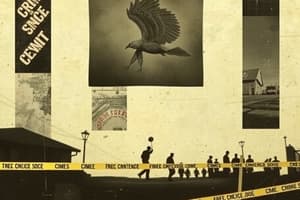Podcast
Questions and Answers
What is the primary responsibility of the Medical Examiner regarding personal property from a deceased person?
What is the primary responsibility of the Medical Examiner regarding personal property from a deceased person?
- To maintain responsibility for the personal property and effects. (correct)
- To oversee the proper storage of the property.
- To release the property to the next of kin.
- To tag and log the property for evidence purposes.
Which of the following is NOT a requirement for the Sheriff's Property Room Personnel to accept custody of property?
Which of the following is NOT a requirement for the Sheriff's Property Room Personnel to accept custody of property?
- Each item must be tagged and recorded individually.
- All required information on each item must be properly included.
- All items must be sealed in a single envelope. (correct)
- A copy of the report must be attached.
What information must an officer provide if they cannot remain at the crime scene for the Evidence Technician?
What information must an officer provide if they cannot remain at the crime scene for the Evidence Technician?
- The legal jurisdiction of the crime.
- A description of the weather conditions.
- The type of offense and whether photos are needed. (correct)
- A list of potential witnesses at the scene.
Which condition must be met to allow the collected property to be accepted as evidence by the BCSO?
Which condition must be met to allow the collected property to be accepted as evidence by the BCSO?
What must an officer do with small, valuable items before submitting them?
What must an officer do with small, valuable items before submitting them?
What is the first step that an officer must take AFTER seizing evidence?
What is the first step that an officer must take AFTER seizing evidence?
How should hazardous evidence be handled according to the procedures?
How should hazardous evidence be handled according to the procedures?
Which of the following best describes the tagging process for narcotics?
Which of the following best describes the tagging process for narcotics?
When can evidence that has no intrinsic value be destroyed?
When can evidence that has no intrinsic value be destroyed?
Who is responsible for processing or examining evidence?
Who is responsible for processing or examining evidence?
What should be done with evidence that requires laboratory examination?
What should be done with evidence that requires laboratory examination?
What is the role of officers in maintaining the status of recovered property?
What is the role of officers in maintaining the status of recovered property?
What must happen before evidence with intrinsic value can be destroyed, sold, or disposed of?
What must happen before evidence with intrinsic value can be destroyed, sold, or disposed of?
What is essential for the release of recovered property to its owner?
What is essential for the release of recovered property to its owner?
Which of the following describes the process for unloading a firearm at a crime scene?
Which of the following describes the process for unloading a firearm at a crime scene?
What must be done with blood evidence collected at a crime scene?
What must be done with blood evidence collected at a crime scene?
Who is primarily responsible for recovering blood evidence at a crime scene?
Who is primarily responsible for recovering blood evidence at a crime scene?
What is necessary for the chain of custody of firearms found at a crime scene?
What is necessary for the chain of custody of firearms found at a crime scene?
What should be avoided when processing blood evidence?
What should be avoided when processing blood evidence?
Under what circumstances can a firearm at a crime scene be disturbed?
Under what circumstances can a firearm at a crime scene be disturbed?
What role does the criminal investigator play in the release of recovered property?
What role does the criminal investigator play in the release of recovered property?
What must officers use to process latent prints at a crime scene?
What must officers use to process latent prints at a crime scene?
Flashcards
Evidence tagging
Evidence tagging
Immediately tagging physical evidence, recording it in a log, and storing it according to department procedures.
Controlled substance handling
Controlled substance handling
Sealed in proper envelopes, tagged, logged, and stored in a designated narcotics drop box.
Narcotics paraphernalia
Narcotics paraphernalia
Separated from controlled substances and tagged as evidence.
Hazardous evidence
Hazardous evidence
Signup and view all the flashcards
Evidence requiring processing
Evidence requiring processing
Signup and view all the flashcards
Evidence technician
Evidence technician
Signup and view all the flashcards
Investigator's reporting
Investigator's reporting
Signup and view all the flashcards
Evidence destruction (low value)
Evidence destruction (low value)
Signup and view all the flashcards
Evidence destruction (high value)
Evidence destruction (high value)
Signup and view all the flashcards
Evidence release
Evidence release
Signup and view all the flashcards
Firearm discovery
Firearm discovery
Signup and view all the flashcards
Firearm unloading
Firearm unloading
Signup and view all the flashcards
Blood evidence collection
Blood evidence collection
Signup and view all the flashcards
Crime scene latent prints
Crime scene latent prints
Signup and view all the flashcards
Major crime scene tech
Major crime scene tech
Signup and view all the flashcards
Deceased property
Deceased property
Signup and view all the flashcards
Non-evidence property handling
Non-evidence property handling
Signup and view all the flashcards
Recovered stolen property
Recovered stolen property
Signup and view all the flashcards
Study Notes
Proper Collection and Handling of Evidence
- All evidence or property seized must be properly tagged and placed in the BCSO Property Room by the seizing officer before the end of their shift.
Tagging Evidence
- Each piece of physical evidence should be tagged as soon as possible, entered in the property log, and stored according to BCSO procedures.
- Controlled substances are sealed in the appropriate envelopes, tagged with a physical evidence tag, logged, and put in the Narcotics Drop Box.
- Any narcotics paraphernalia is separated from the controlled substances if possible and tagged with a physical evidence tag.
- Hazardous evidence is not tagged in the manner of ordinary physical evidence and it is not stored in the Property Room.
- Evidence requiring processing is tagged and then a "Lab Submission Form" is completed.
- Only Evidence Technicians are assigned to process or examine evidence and may also have this work done outside the BCSO.
- The investigator notifies the Evidence Tech/Property Officer in writing of the status of the property and evidence recovered every 30 days.
Destruction and The Release of Evidence
- Destruction of evidence having no intrinsic value (empty cans, paper bags) is by authorization of the assigned investigator, his supervisor, or according to the Code of Criminal Procedures.
- Destruction, sale or disposal of evidence having intrinsic value (cameras, firearms, etc.) occurs only in compliance with the CCP.
- Release of evidence to owners happens after proper identification of the property and with proper authorization from the investigator.
- Court orders on all recovered property requirements are governed in accordance with Chapter 47 (CCP).
- Property is released at the Property Room in accordance with Property Procedures.
Firearm Evidence
- Firearms discovered during the investigation of a crime scene are not disturbed until properly recorded, photographed, or processed, unless the firearm faces destruction, contamination or is a threat to life or property.
- No firearm that is of evidentiary value is unloaded at a crime scene except when failure to unload said weapon constitutes a threatening condition.
- If necessary to unload a firearm at a crime scene, such unloading is done by the investigator, Supervisor or Evidence Technician.
- An Evidence Technician processes every firearm of evidentiary value recovered at a crime scene when possible.
- Chain of custody of firearms found at a crime scene is limited to the original officer recovering the firearm, the Criminal Investigator or his Supervisor and the Evidence Technician.
Blood and Other Evidence
- Blood evidence left by the victim or the suspect at a crime scene shall be recovered by the investigating Officer or Evidence Technician.
- Blood evidence should not be packaged in a plastic bag.
- Blood clothing should be air-dried if possible.
- Package blood evidence in a paper container or bag.
- The Investigating Officer or Evidence Technician recovers body secretion, stains or other material of evidentiary value from the crime scene.
Officers Processing Crime Scene for Latent Prints
- BCSO officers investigating minor criminal incidents process the scene when it is possible.
- Officers processing a crime scene of latent prints may use fingerprint kits provided by the BCSO or self-bought.
- Preserve latent prints obtained at a crime scene on the cards provided in the fingerprint kits.
Evidence Technician Assistance at Crime Scene
- At a major crime scene, an officer who makes a request for an Evidence Technician will remain at the scene, if possible.
- If the requesting officer cannot remain at the scene until the Evidence Technician arrives, the officer will contact the technician and provide the following information:
- Type of offense
- Whether photos are needed
- Prints, including areas or objects of particular concern
- All other pertinent data that bears on the offense or that the Evidence Technician should know
Responsibility for Property Recovered from Deceased Person
- The Medical Examiner has responsibility for personal property and effects recovered from a deceased person.
- Evidence Personnel do not have responsibility for property released at the scene by the Medical Examiner.
- Property released at the scene by the Medical Examiner remains in the custody of the investigating officer who tags it and leaves it in the Property Room.
Property Not Considered Evidence
- BCSO becomes responsible for tagging and logging any property coming into an officer’s possession for safekeeping, or for any other reason.
- The Sheriff's Property Room Personnel becomes responsible for such property, but will not accept custody of any property unless:
- It is properly tagged and logged.
- All required information on each item is properly included on the form.
- Each item is tagged and recorded individually.
- Small, valuable items are individually sealed, inventoried and placed in an evidence envelope by the submitting officer.
- A copy of the report is attached.
- The same conditions as for evidence apply for destruction, sale or disposal of Property.
Disposition of Recovered Stolen Property
Studying That Suits You
Use AI to generate personalized quizzes and flashcards to suit your learning preferences.




